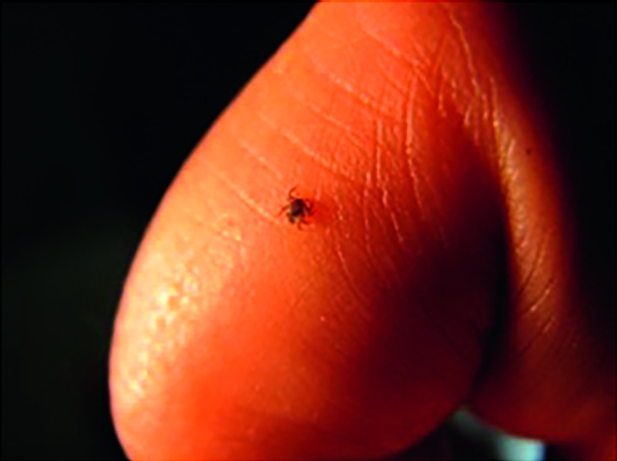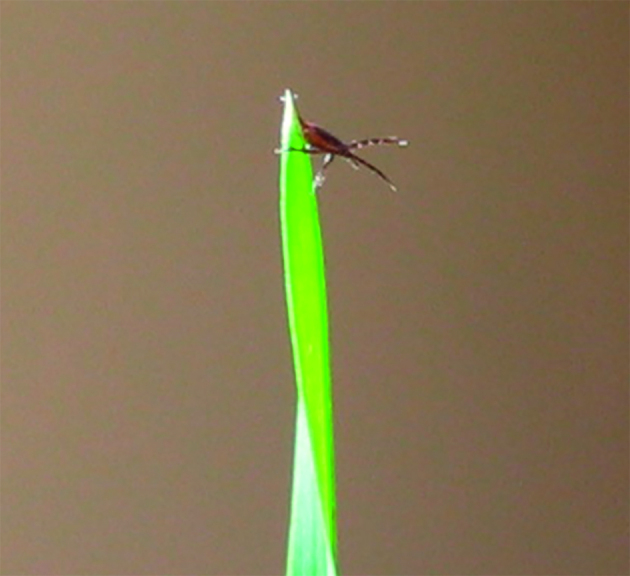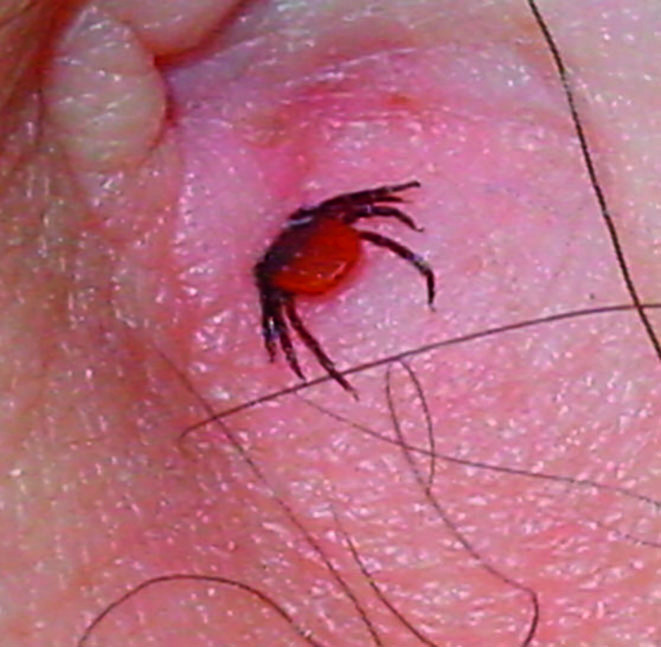TICKS
Ticks are closely related to mites and belong to the class Arachnida, which also includes spiders. There are two morphologically and biologically distinct groups of ticks: the ‘soft ticks’ (Argasidae) and the ‘hard ticks’ (Ixodidae). The most common hard tick in Europe is the castor bean (or sheep) tick, Ixodes ricinus (Figure 1). Not only is this the most abundant tick species, but it can also transmit a variety of pathogens that cause human disease including tick-borne encephalitis (TBE) and Lyme borreliosis.1–3 This renders I. ricinus one of the most dangerous animals in Europe.
Figure 1.

Nymph of Ixodes ricinus on fingertip. © V Fingerle, Oberschleissheim, Germany.
I. ricinus prefers warm, humid environments and tends to be found in locations where humidity exceeds 80% relative humidity (RH). This means that their ideal habitats include woodlands with low scrub, especially along the outskirts of woods and clearances, and also in marshy areas, city parks, and gardens. The ticks are quite passive in their search for a host. They lie in ambush on the tip of a blade of grass (or other plant material) with their front legs out in a behaviour known as ‘questing’ (Figure 2), waiting for a host to pass by in order to latch on to. When ‘questing’, they sway their forelegs back and forth exposing a structure known as the ‘Haller’s organs’. These organs are located towards the end of the first pairs of legs and are able to detect various host odours, humidity, body heat, vibrations, and carbon dioxide. Contrary to popular belief, I. ricinus does not climb very high in the foliage (maximum height is 1.5 m), nor does it jump or fly. In the juvenile stages (larvae and nymphs), it has an extremely broad host range, including small mammals and birds, whereas the adult tick tends to feed on larger mammals such as deer and occasionally humans. The larval and nymphal stages require blood for development and only feed once, whereas a female feeds on blood for the protein to produce eggs and is capable of laying around 2000–3000 eggs.
Figure 2.

Ixodes ricinus in typical questing position at the tip of a blade of grass.
© V Fingerle, Oberschleissheim, Germany.
Because of its humidity requirements, I. ricinus is particularly active on days following rain, especially in early summer. It can survive in the leaf litter covered by snow during mild winters to become active in spring when temperatures exceed 6–8°C.
WHAT ARE THE RISKS?
The risk of becoming infected with a tick-borne disease largely depends on three factors: the density of the tick population, the proportion of ticks infected with a pathogen (infection rate), and factors relating to human behaviour that influence the risk of exposure. In Europe, up to 3% of nymphs carry the TBE virus and up to 5% of adult ticks. In endemic regions, TBE vaccination is recommended for children and adults who are potentially exposed to the bite of I. ricinus. In Europe, TBE is endemic in 27 countries, including the Czech Republic, Slovakia, Austria, southern Germany, and the Baltic states.3,4 The European Centre for Disease Prevention and Control has published a map on tick distribution in Europe.3 Vaccination and tick bite prevention strategies should be exercised for travellers with recreational and/or outdoor exposure in endemic areas.
According to various estimates, around one in ten ticks in Western Europe carries Borrelia burgdorferi s.l., although in some regions this can be as high as one in five. As opposed to TBE, borreliosis can affect people anywhere where I. ricinus occurs. Borreliosis is a notifiable disease in only a few European countries, so numbers reported vary between regions, and large numbers go unreported. The incidence (per 100 000 inhabitants/year) was 43 in the Netherlands, 130 in Switzerland, and 300 in Austria. It has been estimated that >3000 people are affected each year in the UK.3
PREFERRED ATTACHMENT SITES
After a tick has found a host, it walks over the body until it finds a suitable area from which to feed on blood. Usually this is an area where the skin is soft and well supplied with blood, for example, the backs of the knees, crooks, armpits, groin, and navel area (Figure 3), but also along the hair line. Sites most likely bitten by I. ricinus in children include the head region and hair line. In adults the tick prefers the legs, abdomen, breast, and shoulder areas. In timber workers, the arms are commonly bitten as well.5,6
Figure 3.

A female tick attached in the navel region. © V Fingerle, Oberschleissheim, Germany.
PREVENTING TICK-BORNE DISEASES
Vaccination is recommended for all those who live in TBE risk areas or who will travel to these regions. A booster should be administered after 3–5 years thereafter. As no vaccine is available against Lyme borreliosis, prevention of tick bite offers the best protection against this condition. The Royal College of General Practitioners has produced an e-learning course on Lyme borreliosis available to all health professionals (http://elearning.rcgp.org.uk/course/info.php?popup=0&id=164).
Ticks are most easily spotted on light-coloured clothing; unfortunately, however, ticks also are preferentially attracted to light-coloured clothing. During outdoor activities in tick-prone areas, the wearing of protective clothing is advisable. This includes light-coloured clothing, long-sleeved shirts, and long trousers with hems tucked into the boots or socks, and the wearing of rubber boots. Walking in the centre of trails is recommended to avoid brushing against any vegetation. When returning home, a shower should be taken soon and a thorough body inspection for any adhering tick should be conducted, with particular emphasis on searching the backs of the knees, armpits, and groin area. Clothing should be placed in a hot dryer for 20 minutes to kill any ticks still present.5–8
As Borreliae live in the intestines of ticks, it takes time before the bacteria are transmitted to the host. Therefore, an infection is less likely during the first 12 hours after the tick has attached. In animal studies, transmission rates 18–24 hours post-attachment ranged from 0–50% with nearly complete transmission occurring after 72 hours. The implication is that, the faster a tick is removed, the lower the potential risk of becoming infected with a Borrelia. Tick removal is best achieved by using fine-tipped tweezers or forceps, and grasping the tick as close to the skin as possible.9 The tick should be loosened by gentle twisting before it can be finally pulled out slowly. Tick parts remaining in the wound are not a problem and will shed as the skin naturally sloughs. Applying an antiseptic to the wound can reduce the risk of secondary infections at the bite site, although this is rare in otherwise healthy individuals. Whether or not local application of azithromycin cream can prevent clinical Lyme borreliosis is currently being researched.
Screening for ticks should include a check of pets. It has been shown that individuals with pets often have a slightly increased antibody titre, particularly those with cats. Ticks removed should be put into folded paper (to reduce infection risk) and then crushed using a hard object. Alternatively, they can be deposited in a 40% alcoholic solution, or killed with boiling water after removal.
REPELLENTS ARE EFFECTIVE AGAINST TICKS
Insect repellents in European Union countries undergo a registration process, during which their efficacy is evaluated along with their potential harm to human health. This means that registered products are deemed safe to use when the label directions are followed, and are effective at reducing bites from bloodsucking arthropods. Many of the common repellents against mosquitoes also protect against ticks, particularly those containing DEET, picaridin, or EBAAP.9 This also holds true to a lesser extent for fatty acids, for example, caprylic acid (in coconut oil) and lauric acid. Their advantages are their good toxicity profile and cutaneous tolerance (Table 1). However, protection times of repellents against ticks can be much shorter than that for mosquitoes due to a higher biting pressure with ticks.9 For added protection for those who regularly engage in outdoor activities or have the potential for occupational exposure to ticks, impregnation of clothes with a long-lasting pyrethroid, such as permethrin, can provide additional protection.
Table. 1.
Active ingredients of products used to repel ticks in Europe (against Ixodes ricinus)
| Active ingredient | Minimum age,a years | Use during pregnancy and/or breast feeding | Remarks | Estimated protection timea |
|---|---|---|---|---|
| DEET | 3 | No | May affect plastic | 20%: 4 hours |
| Picaridin | 2 | Possible | 10–20%: 4 hours | |
| EBAAP | 1 | Possible | Only few side effects reported | 10–20%: 4 hours |
| PMD | 3 | Nob | Sensitising potential | 30%: 2 hours |
| Fatty acids | 0 | Possible | Up to 2 hours |
These are estimations only. Protection times depend on the type and percentage of formulation.
No data.
WHAT TO DO WITH CLOTHES?
Washing clothes at ≤40°C is ineffective and ticks will easily survive. Therefore all clothes should be washed or dried at 60°C. Ticks that have fallen off the host or clothes can easily survive for 1 or 2 weeks and will be searching for a new host.
PROTECTION WHEN TRAVELLING
During the registration process of tick repellents, efficacy is determined against ticks that belong to the species most prevalent in the market region. In Europe, this is I. ricinus, and, consequently, repellent products are tested against this species. It has been demonstrated that repellent products available in Europe also protect against ticks transmitting Lyme disease in the US, notably the blacklegged tick, Ixodes scapularis.9
Funding
None.
Provenance
Freely submitted; externally peer reviewed.
Competing interests
The authors have declared no competing interests.
Discuss this article
Contribute and read comments about this article: www.bjgp.org/letters
REFERENCES
- 1. Lyme Disease Action. About ticks. 2016. http://www.lymediseaseaction.org.uk/about-ticks/ (accessed 11 Aug 2016)
- 2. Lyme Disease Action. Ticks in Britain. 2008. http://www.lymediseaseaction.org.uk/wp-content/uploads/2012/10/lda004-2.pdf (accessed 11 Aug 2016)
- 3.European Centre for Disease Prevention and Control. Tick-borne diseases. 2016. http://ecdc.europa.eu/en/healthtopics/emerging_and_vector-borne_diseases/tick_borne_diseases/pages/index.aspx (accessed 11 Aug 2016)
- 4.Rizzoli A, Hauffe HC, Carpi G, et al. Lyme borreliosis in Europe. Euro Surveill. 2011;16(27) pii:19906. [PubMed] [Google Scholar]
- 5.Aberer E. What should one do in case of a tick bite? Curr Probl Dermatol. 2009;37:155–166. doi: 10.1159/000213073. [DOI] [PubMed] [Google Scholar]
- 6.Piesman J, Eisen L. Prevention of tick-borne diseases. Annu Rev Entomol. 2008;53:323–343. doi: 10.1146/annurev.ento.53.103106.093429. [DOI] [PubMed] [Google Scholar]
- 7. Lyme Disease Action. Tick bite risk reduction. http://www.lymediseaseaction.org.uk/about-ticks/tick-bite-risk-reduction/ (accessed 11 Aug 2016)
- 8. Lyme Disease Action. Tick removal. http://www.lymediseaseaction.org.uk/about-ticks/tick-removal/ (accessed 11 Aug 2016)
- 9.US Environmental Protection Agency Find the insect repellent that is right for you. 2016. https://www.epa.gov/insect-repellents/find-insect-repellent-right-you (accessed 11 Aug 2016)


